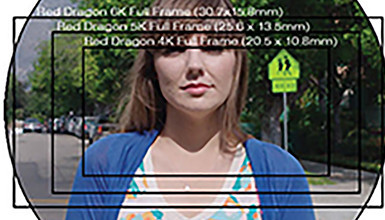WHY ONE VERSUS THE OTHER?
First off, CMOS does not necessarily mean rolling shutter and CCD does not necessarily mean global shutter. Predominantly that is the case, but it is not an absolute. There are CCD chips with rolling shutter and CMOS chips with global shutters. Also, the notion of rolling shutter = bad / global shutter = good is not particularly true either. A rolling shutter can have a more organic, more -- wait for it -- FILMIC look. Note I said 'can' as there are no absolutes in this world. A rolling shutter can also dramatically increase the fill factor of a photosite, making for greater sensitivity and a higher signal to noise ratio.
All of the technical, industrial Phantom cameras from Vision Research have global shutters, as they have a specific technical need to capture an image all at once for analysis purposes. But when they decided to make some Digital Cinema cameras, the Phantom HD and Phantom 65 were both designed with rolling shutters instead. And all rolling shutters are not alike. For instance, because of the high-speed nature of the Phantom cameras, the read/write time of the rolling shutter of a Phantom HD is just one millisecond. That can be long enough not to sync with a fast strobe or lightening bolt, but you'd be hard-pressed to see any "wobblies" in a whip pan or helicopter shot.
A rolling shutter does not scan one line, then another and then another. It is more of a cascading effect. For example, when the first line of the sensor reads around 5% across, the next line starts and reads 5%, and then the third line starts and so on. That's why it can tilt an image with movement in one direction and break it apart with movement in the other.
SO ANYWAY, HOW DO THE EX1 & EX3 DO?
Pretty good in my book. Yes, if I shake the camera in crazy ways I can definitely see the effect. But in general there is no issue even in handheld work. It is fine for car shots, and in fact Abel rented a pile of EX3 cameras to Ugly Betty for a couple of days of car rig work. They pointed them out in every possible direction on a vehicle-mounted stabilizer head, locked them in sync and drove all over New York. They used the footage for background plates in all their driving process shots. I've seen some examples of rolling shutter artifacts that would not be appropriate for professional image capture. But that is certainly not the case with the EX3.
DOES A ROLLING SHUTTER CAUSE LIGHTS TO FLICKER?
Don't get confused by the function of a rolling shutter. Think of it like a mechanical film shutter. There is only a small fraction of the time that it is physically covering up or uncovering the imager (the read/write time). The vast majority of the time the imager is either exposed to light or is not collecting photons.
An LED light, some small on camera lights, tungsten lights, and even HMI lights use pulse-modulation to control exposure. This is because other forms of dimming, such as lower voltage, can cause color shift. Different lights do it differently and different camera sensors are affected by it differently.
As a test, I pointed an EX1 camera at a variety of LED lights (LitePanel 1x1, Rosco LitePad, LEDZ, Switronix TorchLED) here in our Sales showroom. I ran the camera at different frame rates and with different shutter speeds. I randomly adjusted the lights throughout their range. I was unable to create any flicker. I WAS able to create flicker with a Phantom camera shooting at very high framerate, but this was true for either Global or Rolling Shutter cameras.
So does a rolling shutter cause lights to flicker? Nope, no more than any other form of shutter.











